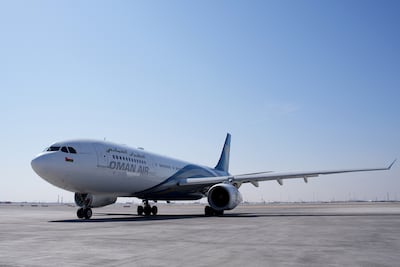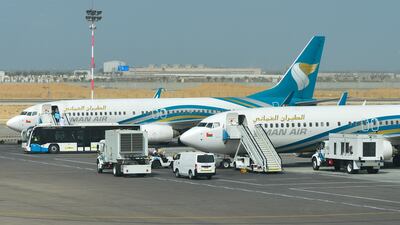Oman Air is cutting unprofitable routes, simplifying its fleet, reducing costs and resizing its workforce as part of a turnaround plan to "fix foundations" before returning to growth, its chief executive has said.
The state-owned airline, which announced its first new route in five years with the launch of flights to Rome in December, aims to expand in 2025 through better aircraft utilisation and increasing flight frequencies, Con Korfiatis said during the Routes World conference in Bahrain.
The airline also aims to break even by 2027 as part of its restructuring plan that began at the end of last year, he said.
"If you're putting up a two-storey house, you build the foundations for a two-storey house, but over the years we became a five-storey house on the same foundation. So it's time to fix those foundations and then you can go back to growth," Mr Korfiatis said in an interview on the sidelines of the event.
Mr Korfiatis, who has 30 years of experience in the aviation industry, was appointed chief executive of the airline in May with the remit of steering the airline's transformation to turn its finances around.
A strong flag carrier is needed to help implement Oman's Vision 2040 plan to diversify its economy and reduce its reliance on oil revenue. Under that, the sultanate aims to increase the tourism sector’s contribution to 10 per cent of GDP and attract 11.7 million tourists by 2040.
The World Tourism and Travel Council (WTTC) forecasts that Oman's travel and tourism sector's contribution to the GDP in 2024 will exceed 3.3 billion Oman rials ($8.6 billion), or 7.6 per cent of the economy, up from 2.8 billion rials in 2023. The sector is projected to employ more than 206,000 people this year, up from 191,500 last year.
'Simplifying the fleet'
Oman Air currently has 42 planes in its fleet, with 32 of these flying. The 10 Airbus A330s removed from service include seven jets on short-term lease to Qatar Airways and three that are grounded before they are to be sold early next year, Mr Korfiatis said.
The airline currently operates 10 Boeing 787-9s and 22 Boeing 737s. It plans to shift to an all-Boeing 737 Max narrow-body fleet by the end of 2026, once it has phased out the older 737-800s and 737-900s as their leases expire, he said.
The airline expects delivery of five more 737 Max by mid-2025 and two 787s in the first half of next year. Another six 787 Dreamliners will join the fleet between 2026 and 2028. Of the 737 Max deliveries expected next year, some will be delayed by months but "Boeing is keeping us informed", Mr Korfiatis said.
The delivery should ideally coincide with the return of older versions of the aircraft to lessors, so "it's a bit of a balancing act when the Maxs are running some months late". The airline would consider extending some of the aircraft leases or entering into wet lease arrangements to cover any short-term gaps if they arise, he said.
Global airlines are grappling with delayed plane deliveries as Boeing deals with a safety and quality crisis, a union workers' strike and increased regulatory scrutiny of its production processes.
"From a commercial point of view, [delivery delays] don't help us, but the whole industry's eyes are open now, we see what's there and we roll with it until things stabilise – and they will eventually," Mr Korfiatis said.
The airline this year reduced its network capacity by 30 per cent, cutting unprofitable routes as part of restructuring efforts. The move was necessary "to stem the bleeding while we do the transformation work", he said. "Once we've stabilised that and we've put efficiencies in the organisation, we need to get our cost base down to where it needs to be, then we will have a platform to go back to growth."
The airline currently operates 42 routes, down from "the high 40s", as it halted some to Pakistan, India and Sri Lanka, Mr Korfiatis said.
"We will actually grow next year without increasing the fleet ... through some clever rescheduling we are able to do some more flying without increasing the number of aircraft. We can get more flying out of existing aircraft for both the narrow-bodies and wide-bodies," he said.
The airline has also removed its first-class offering and repurposed it to create the new Business Studio.
"The first-class product was flying an empty cabin and our business class was flying a full cabin, so it was clear that this is not a first-class market that we're in," the executive said.
"We've already seen results: instead of flying empty cabins, we're now getting people in the front [of the aircraft]."
The new route from Muscat to Rome starting in December will operate four times per week, with one-way fares from 75 rials. Oman Air is considering adding new routes in markets in the Middle East and Europe as early as 2026, Mr Korfiatis said, without providing further details.
Oman Air will next year join the Oneworld Alliance, which will help the airline increase its connectivity.
"Through the virtual network that you create through the alliance, you improve your network footprint substantially in a way that we could never do by ourselves," Mr Korfiatis said.
Mercer, the investment consulting arm of US services company Marsh & McLennan, expects its wealth division to at least double its assets under management (AUM) in the Middle East as wealth in the region continues to grow despite economic headwinds, a company official said.
Mercer Wealth, which globally has $160 billion in AUM, plans to boost its AUM in the region to $2-$3bn in the next 2-3 years from the present $1bn, said Yasir AbuShaban, a Dubai-based principal with Mercer Wealth.
“Within the next two to three years, we are looking at reaching $2 to $3 billion as a conservative estimate and we do see an opportunity to do so,” said Mr AbuShaban.
Mercer does not directly make investments, but allocates clients’ money they have discretion to, to professional asset managers. They also provide advice to clients.
“We have buying power. We can negotiate on their (client’s) behalf with asset managers to provide them lower fees than they otherwise would have to get on their own,” he added.
Mercer Wealth’s clients include sovereign wealth funds, family offices, and insurance companies among others.
From its office in Dubai, Mercer also looks after Africa, India and Turkey, where they also see opportunity for growth.
Wealth creation in Middle East and Africa (MEA) grew 8.5 per cent to $8.1 trillion last year from $7.5tn in 2015, higher than last year’s global average of 6 per cent and the second-highest growth in a region after Asia-Pacific which grew 9.9 per cent, according to consultancy Boston Consulting Group (BCG). In the region, where wealth grew just 1.9 per cent in 2015 compared with 2014, a pickup in oil prices has helped in wealth generation.
BCG is forecasting MEA wealth will rise to $12tn by 2021, growing at an annual average of 8 per cent.
Drivers of wealth generation in the region will be split evenly between new wealth creation and growth of performance of existing assets, according to BCG.
Another general trend in the region is clients’ looking for a comprehensive approach to investing, according to Mr AbuShaban.
“Institutional investors or some of the families are seeing a slowdown in the available capital they have to invest and in that sense they are looking at optimizing the way they manage their portfolios and making sure they are not investing haphazardly and different parts of their investment are working together,” said Mr AbuShaban.
Some clients also have a higher appetite for risk, given the low interest-rate environment that does not provide enough yield for some institutional investors. These clients are keen to invest in illiquid assets, such as private equity and infrastructure.
“What we have seen is a desire for higher returns in what has been a low-return environment specifically in various fixed income or bonds,” he said.
“In this environment, we have seen a de facto increase in the risk that clients are taking in things like illiquid investments, private equity investments, infrastructure and private debt, those kind of investments were higher illiquidity results in incrementally higher returns.”
The Abu Dhabi Investment Authority, one of the largest sovereign wealth funds, said in its 2016 report that has gradually increased its exposure in direct private equity and private credit transactions, mainly in Asian markets and especially in China and India. The authority’s private equity department focused on structured equities owing to “their defensive characteristics.”
The specs
Engine: 4.0-litre V8 twin-turbocharged and three electric motors
Power: Combined output 920hp
Torque: 730Nm at 4,000-7,000rpm
Transmission: 8-speed dual-clutch automatic
Fuel consumption: 11.2L/100km
On sale: Now, deliveries expected later in 2025
Price: expected to start at Dh1,432,000
Electric scooters: some rules to remember
- Riders must be 14-years-old or over
- Wear a protective helmet
- Park the electric scooter in designated parking lots (if any)
- Do not leave electric scooter in locations that obstruct traffic or pedestrians
- Solo riders only, no passengers allowed
- Do not drive outside designated lanes
The Ashes
Results
First Test, Brisbane: Australia won by 10 wickets
Second Test, Adelaide: Australia won by 120 runs
Third Test, Perth: Australia won by an innings and 41 runs
Fourth Test: Melbourne: Drawn
Fifth Test: Australia won by an innings and 123 runs
Stats at a glance:
Cost: 1.05 billion pounds (Dh 4.8 billion)
Number in service: 6
Complement 191 (space for up to 285)
Top speed: over 32 knots
Range: Over 7,000 nautical miles
Length 152.4 m
Displacement: 8,700 tonnes
Beam: 21.2 m
Draught: 7.4 m
COMPANY%20PROFILE
%3Cp%3E%3Cstrong%3ECompany%3A%20%3C%2Fstrong%3EMascotte%20Health%3C%2Fp%3E%0A%3Cp%3E%3Cstrong%3EStarted%3A%20%3C%2Fstrong%3E2023%3C%2Fp%3E%0A%3Cp%3E%3Cstrong%3EBased%3A%20%3C%2Fstrong%3EMiami%2C%20US%3C%2Fp%3E%0A%3Cp%3E%3Cstrong%3EFounder%3A%3C%2Fstrong%3E%20Bora%20Hamamcioglu%3C%2Fp%3E%0A%3Cp%3E%3Cstrong%3ESector%3A%20%3C%2Fstrong%3EOnline%20veterinary%20service%20provider%3C%2Fp%3E%0A%3Cp%3E%3Cstrong%3EInvestment%20stage%3A%3C%2Fstrong%3E%20%241.2%20million%20raised%20in%20seed%20funding%3C%2Fp%3E%0A
More on animal trafficking
What is the Supreme Petroleum Council?
The Abu Dhabi Supreme Petroleum Council was established in 1988 and is the highest governing body in Abu Dhabi’s oil and gas industry. The council formulates, oversees and executes the emirate’s petroleum-related policies. It also approves the allocation of capital spending across state-owned Adnoc’s upstream, downstream and midstream operations and functions as the company’s board of directors. The SPC’s mandate is also required for auctioning oil and gas concessions in Abu Dhabi and for awarding blocks to international oil companies. The council is chaired by Sheikh Khalifa, the President and Ruler of Abu Dhabi while Sheikh Mohamed bin Zayed, Abu Dhabi’s Crown Prince and Deputy Supreme Commander of the Armed Forces, is the vice chairman.
TOUR RESULTS AND FIXTURES
June 3: NZ Provincial Barbarians 7 Lions 13
June 7: Blues 22 Lions 16
June 10: Crusaders 3 Lions 12
June 13: Highlanders 23 Lions 22
June 17: Maori All Blacks 10 Lions 32
June 20: Chiefs 6 Lions 34
June 24: New Zealand 30 Lions 15
June 27: Hurricanes 31 Lions 31
July 1: New Zealand 21 Lions 24
July 8: New Zealand v Lions
Last 10 NBA champions
2017: Golden State bt Cleveland 4-1
2016: Cleveland bt Golden State 4-3
2015: Golden State bt Cleveland 4-2
2014: San Antonio bt Miami 4-1
2013: Miami bt San Antonio 4-3
2012: Miami bt Oklahoma City 4-1
2011: Dallas bt Miami 4-2
2010: Los Angeles Lakers bt Boston 4-3
2009: Los Angeles Lakers bt Orlando 4-1
2008: Boston bt Los Angeles Lakers 4-2
Guide to intelligent investing
Investing success often hinges on discipline and perspective. As markets fluctuate, remember these guiding principles:
- Stay invested: Time in the market, not timing the market, is critical to long-term gains.
- Rational thinking: Breathe and avoid emotional decision-making; let logic and planning guide your actions.
- Strategic patience: Understand why you’re investing and allow time for your strategies to unfold.
Star%20Wars%3A%20Episode%20I%20%E2%80%93%20The%20Phantom%20Menace
%3Cp%3E%3Cstrong%3EDeveloper%3A%3C%2Fstrong%3E%20Big%20Ape%20Productions%3Cbr%3E%3Cstrong%3EPublisher%3A%3C%2Fstrong%3E%20LucasArts%3Cbr%3E%3Cstrong%3EConsoles%3A%3C%2Fstrong%3E%20PC%2C%20PlayStation%3Cbr%3E%3Cstrong%3ERating%3A%3C%2Fstrong%3E%202%2F5%3C%2Fp%3E%0A
RESULT
Fifth ODI, at Headingley
England 351/9
Pakistan 297
England win by 54 runs (win series 4-0)
All%20The%20Light%20We%20Cannot%20See%20
%3Cp%3E%3Cstrong%3ECreator%3A%20%3C%2Fstrong%3ESteven%20Knight%3C%2Fp%3E%0A%3Cp%3E%3Cstrong%3EStars%3A%C2%A0%3C%2Fstrong%3EMark%20Ruffalo%2C%20Hugh%20Laurie%2C%20Aria%20Mia%20Loberti%3C%2Fp%3E%0A%3Cp%3E%3Cstrong%3ERating%3A%20%3C%2Fstrong%3E1%2F5%C2%A0%3C%2Fp%3E%0A
The biog
Name: Atheja Ali Busaibah
Date of birth: 15 November, 1951
Favourite books: Ihsan Abdel Quddous books, such as “The Sun will Never Set”
Hobbies: Reading and writing poetry
How it works
Booklava works on a subscription model. On signing up you receive a free book as part of a 30-day-trial period, after which you pay US$9.99 (Dh36.70) per month to gain access to a library of books and discounts of up to 30 per cent on selected titles. You can cancel your subscription at any time. For more details go to www.booklava.com
The lowdown
Badla
Rating: 2.5/5
Produced by: Red Chillies, Azure Entertainment
Director: Sujoy Ghosh
Cast: Amitabh Bachchan, Taapsee Pannu, Amrita Singh, Tony Luke
Tonight's Chat on The National
Tonight's Chat is a series of online conversations on The National. The series features a diverse range of celebrities, politicians and business leaders from around the Arab world.
Tonight’s Chat host Ricardo Karam is a renowned author and broadcaster who has previously interviewed Bill Gates, Carlos Ghosn, Andre Agassi and the late Zaha Hadid, among others.
Intellectually curious and thought-provoking, Tonight’s Chat moves the conversation forward.
Facebook | Our website | Instagram




